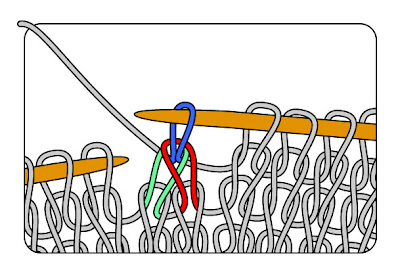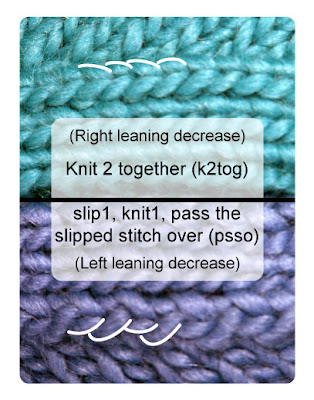Here is a new method for left-leaning decreases, a method I call SYTK. SYTK stands for "slip, yank, twist, knit." Of all the variations on left-leaning decreases I've experimented with over the years, I think this one lies closest to the intersection of good looks and ease of creation. Some alternatives may look as good, but they are more complicated to make, some alternatives may be as easy to make, but don't look as good. The advantages of the SYTK are these:
- it can be worked from the front (a major advantage, to me, at any rate)
- it requires no re-ordering of stitches (the stitches are never taken off the needles and reversed in position--a procedure which, although it leads to good results, I find annoying and time consuming).
- it gives a nearly perfect match for k2tog
THE SYTK, illustrated
Step 1 (below) Slip the first (red) stitch from the left needle to the right needle. Slip the stitch KNITWISE (left arm forward) as shown. This is the SLIP part of the SYTK maneuver--the part represented by the first letter "S."
Step 2 (below) Leaving the red stitch on the right needle, insert the tip of the right needle into the next stitch (green) on the left needle. Be sure the tip of the right needle is inserted under the right arm of the green stitch, as shown. Now comes the fun part: making sure that you have enough of each needle inserted to anchor the stitch completely, perform the "Y" part of the SYTK--the YANK! Pull the right arm of the green stitch towards you with the right needle at the same time as you pull the left arm of the green stitch away from you with the left needle, thus opening up the stitch as much as possible. You don't want to bend your needle or stretch the actual fibers of the stitch, but you certainly want to YANK enough to pull all the slack yarn from both surrounding stitches into the green stitch.

Step 3a (below) Begin the TWIST ("T") part of the SYTK decrease by removing the right needle tip, thus returning the now-enlarged green stitch to the tip of the left needle.

Step 3b (below) Using the tip of the right needle, TWIST the green stitch, and return it to the tip of the left needle, as shown. Check to be sure that the formerly right arm lies ON TOP, as illustrated by the little PURPLE ARROW. If the stitch is twisted the wrong way, take it off and re-twist it so that it lays as shown--this is fairly important to the final appearance.

Step 3c (below) Return the much-enlarged, now-twisted green stitch to the tip of the left needle.

Step 3d (below) Slip the red stitch onto the tip of the left needle, taking care that it remains LEFT ARM FORWARD. This ends the "Twist" portion of SYTK, the "T."

Step 4 (below) Insert the right needle into the BACK ARMS of the red and green stitches, as shown, and twitch the standing yarn over the right needle, in position to knit a stitch.

FINISHED SYTK (below) Draw the standing yarn through the red and the green stitches to make a new stitch (blue). This is the final, the KNIT step of SYTK--the "K."

You should now have a rather nice left-leaning decrease looking at you from your right needle. The reason this works is because it mimics the situation you get with a k2tog. Recall from the first post of this series that a k2tog is performed in such a manner as to squeeze the hidden second stitch AND ALL ITS EXCESS YARN behind the first stitch. Recall from the second post of the series that both ssk and psso leave the first stitch on the surface of the fabric, together with all the excess yarn it has accumulated from being manipulated. By adding a YANK step to SYTK, the excess yarn from the surface stitch is all transferred to the hidden second stitch, and by adding a TWIST step, that excess yarn is prevented from slipping out again. Further, the twist step aligns the only visible part of the second stitch (the arm which started off as the right arm, but was twisted forward to become the left arm) to lie in the same direction as the top stitch. In other words, the TWIST step makes the only visible portion of the second (green) stitch follow the left-leaning orientation of the top (red) stitch. Here is the photographic evidence:

A final note: In grabby yarn, the top (red) stitch may not be completely re-oriented by the slip maneuvers you have performed on it in steps 1 and 3d. This lack of orientation reveals itself in a proportionately shorter right arm, and a proportionately longer left arm, and disturbs the appearance of the left decrease column. Therefore, in a grabby yarn you may wish to add one further step.
Per the illustration below, after the decrease has been finished, insert the tip of the left needle under the right arm of the already-knitted top (red) stitch. GENTLY adjust the red stitch to lengthen the right arm while simultaneously shortening the left arm, and you will see that the stitch orientation improves. Be MILD in your adjustment--you only want to redistribute yarn in from the left arm of the top stitch to the right arm of the same stitch. You don't want to tug so hard that you undo all your previous effort--you don't want to drag slack back from the second (green) stitch and dump it back into the top (red) stitch.

Dear readers--have fun with this, and I hope you like it as well as I do!
--TECHknitter (You have been reading TECHknitting on "SYTK (slip, yank, twist, knit), a new method for left-leaning decreases.")











